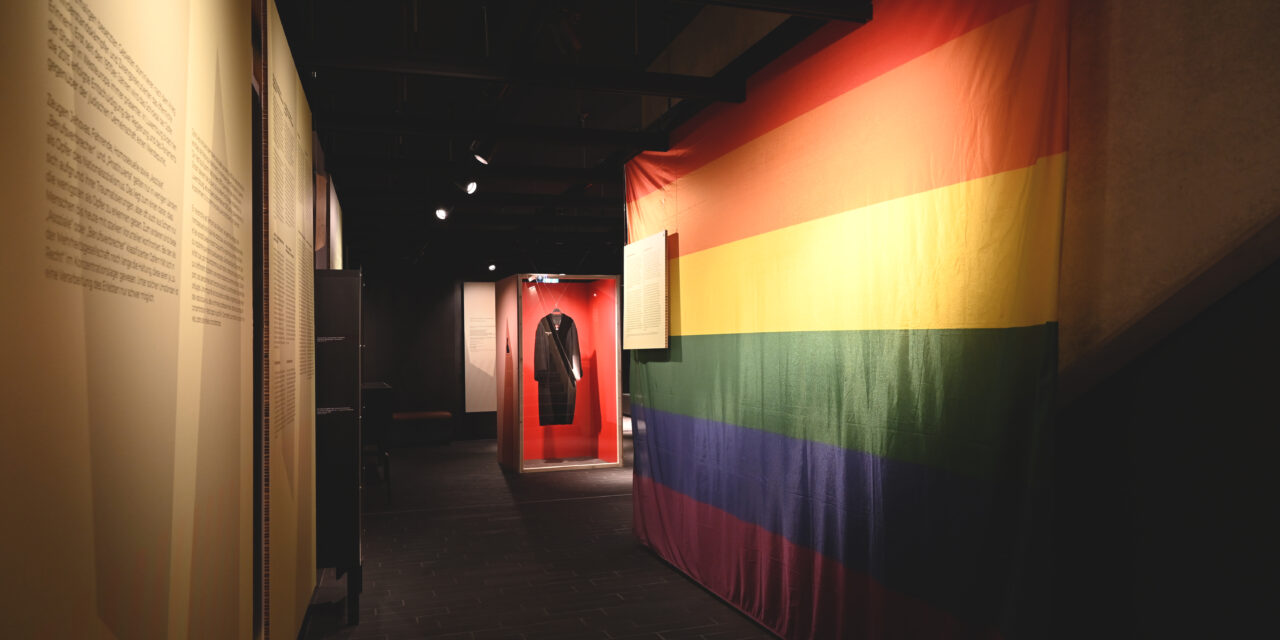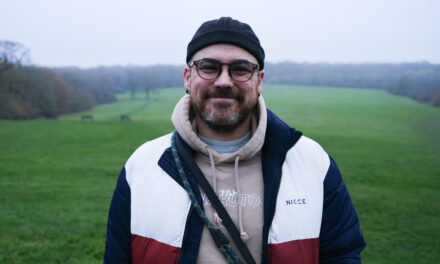Since March 13, 2024, the new temporary exhibition on the “Forgotten Victims of the Nazi Regime in Luxembourg” has been on display in the basement of the Musée National de la Résistance et des Droits Humains in Esch/Alzette.
The exhibition tells the up to now unnoticed – sometimes uncomfortable – story of eight victims (groups), including homosexual men.
After the war, public memory in Luxembourg was dominated by the former resistance fighters and forced recruits. In the struggle for remembrance waged by both groups, there was no room for the numerous civilian victims who were persecuted by the Nazi occupiers for (social) racist reasons. Recognition as victims of National Socialism was associated with a high social status and entitlement to special state payments. The lack of social and historical interest in the fate of (socially) racially persecuted minorities led to a late reappraisal. It is only since the 2010s that more attention has been paid to the fate of Jews in the country. Other people (groups), such as Jehovah’s Witnesses, homosexuals, Black people, Sinti and Yenish or people with mental or physical disabilities, have been ignored to this day. Even today, only a few memorials or commemorative events remind us of the victims – sometimes only on the initiative of corresponding interest groups such as Rosa Lëtzebuerg.
However, the exhibition “Forgotten Victims” not only attempts to explain the racial and eugenic thinking of the National Socialists to visitors, but also to define its origins.
The concept of eugenics, for example, developed in the 19th century from Charles Darwin’s theory of evolution. Applied to humans, the Darwinian principle of “natural selection” was intended to justify the elimination of “inferiors”. In Germany, similar ideas emerged under the term “racial hygiene”. In the United States and Scandinavia, eugenic laws led to the mass forced sterilization of members of indigenous population groups classified as “mentally impaired”. Racial thinking and eugenics also gained influence in Luxembourg in the interwar period, as evidenced by the so-called “human zoos” on the Schueberfouer or the failed bill to introduce a marriage health certificate in 1927. Racial and eugenic thinking was thus widespread and accepted at the beginning of the 20th century, even in democratic countries.
With the aim of perfecting the “German national body”, the National Socialists attempted to combat political or social behavior that was perceived as deviant (e.g. homosexuals) and to eliminate “hereditary diseases” (e.g. people with disabilities) and “foreign bodies” (Jews, Sinti and Roma). In contrast to the interests of the “national community”, the rights of the individual did not count in the Nazi state.
Within this National Socialist ideology, which was based on ideas of racial hygiene, homosexual men were considered to be subversive to the state.
On the one hand, they would corrupt the youth and, on the other, their childlessness would not contribute to strengthening the “national body”. Homosexuality was already prosecuted in the German Empire with the introduction of §175. However, the National Socialists tightened §175 by adding §175a, which meant that significantly longer prison sentences could be imposed. In their persecution, the National Socialists distinguished between the “seduced” and the “seducers”. While the former could be reintegrated into the “national community” through “re-education” – in particular through hard forced labor – the latter had to be removed from the community. If they had multiple criminal convictions, they could be taken into “protective custody” and deported to concentration camps for “preventive crime control”. There they were marked with the “pink triangle”. In total, around 50,000 men were sentenced because of their sexuality. Between 5,000 and 10,000 men were deported to concentration camps, where many of them perished or were killed in murder operations.
Section 175 affected the lives of all homosexuals in the Reich, including lesbian women.
Overall, sexual relationships between women in the “Third Reich” were not prosecuted under §175. One of the reasons for this was that women did not play a political role in the male-dominated Nazi state and were therefore considered less of a threat to the continued existence of the regime. From their point of view, the continued existence of the German “national body” was also not endangered by female homosexuality, as women could be forced to reproduce if necessary. Proving female homosexuality was also considered difficult, as women were more likely to live inconspicuously in long-term same-sex relationships than men. Lesbian women were threatened with the withdrawal of custody of their children and social exclusion. Women were generally denied an existence independent of men. Magazines for “girlfriends”, pubs and organizations were banned or closed. In criminal proceedings, homosexuality was an aggravating factor for women and in concentration camps they risked becoming victims of violence and forced prostitution. However, it is difficult to determine the exact number of victims because research is still in its early stages.
While homosexual men in Nazi Germany already had to fear (severe) prison sentences and concentration camp punishments, among other things, homosexual relationships were not yet prosecuted in Luxembourg.
However, this does not mean that homosexuals were socially accepted. Homosexuality was a taboo that was often reported in the press in connection with crimes. This fueled homophobic resentment among the population. Homosexuality was seen – even by the church – as “unnatural” and a danger to young people. Homosexual Luxembourgers risked being socially ostracized. Homosexual foreigners, on the other hand, could be expelled from the country. Shortly before the annexation of Luxembourg in January 1940, the first initiatives were taken at ministerial level to make homosexuality a criminal offense, but these were only implemented under the National Socialists.
After the occupation of Luxembourg, Gauleiter Gustav Simon was given the task of ensuring the “Germanization” and “cleansing” of the Luxembourg population as the so-called head of the civil administration. All departments of the NSDAP and the state were mobilized to persecute them. In addition to the Secret State Police (Gestapo), the administrative, judicial and health systems, which were reorganized along Nazi lines, also carried out political repression as well as persecutions motivated by “racial hygiene”. From September 1940, anti-Semitic racial laws were introduced in the country. Further “racial hygiene” measures were to follow: Homosexuality became a criminal offense for the first time.
The first arrests were made shortly afterwards. The criminal investigation department (Kripo) and the Gestapo were responsible for prosecuting homosexual men. Most of the men were arrested during raids and on the basis of denunciations. The German and Luxembourg judges made very different decisions in their sentences. Most of the accused were sentenced to several months in prison. Only those who were seen as a danger to the “national body” and the youth were sentenced to several years in prison. In total, around 30 Luxembourgish men were sentenced on the basis of §§175 and 175a. In the prisons, the convicted men were to be re-educated through hard labor. Only a few were taken into “protective custody” before or after their sentence and deported to concentration camps, where they were given the “pink triangle”. Marked in this way, they were subjected to abuse by the guards and their fellow prisoners.
Due to a lack of historical research, the Nazi persecution of lesbian women and trans people in Luxembourg remains in the dark. The exhibition therefore also serves to inspire other historians and researchers to also investigate these (groups of) victims.
Behind these often complex and very impersonal mechanisms of persecution, an attempt is also made to give visitors an understanding of the personal fates behind Nazi persecution. Staying true to this line, this article will end with three sample biographies that cover the various cases, from imprisonment to concentration camp detention to intersectionality.
It will begin with the only case to date of a lesbian woman persecuted in the country.
Born in 1899, Gertrud Schloß came from a Jewish family in Trier. The writer was politically active from her youth: she was a member of the peace and women’s movements; as a journalist and writer, she criticized National Socialism. She was a lesbian and was very open about her homosexuality in her writing. In 1939, Gertrud fled to her mother and brother in Walferdingen, Luxembourg. During her stay in Luxembourg, she lived off the income she received from the publication of her novel “Zwischen Pflicht und Liebe” in the Escher Tageblatt. Gertrud hoped to emigrate from Luxembourg to the USA, but was unsuccessful. After the annexation of Luxembourg in 1941, she was transported to the “Jewish old people’s home” in Fünfbrunnen and deported to the Litzmannstadt ghetto on October 16, 1941. A few months later, presumably in January 1942, she was murdered in the Kulmhof (Chełmno) extermination camp.
Gertrud Schloß is a good example of intersectionality. A term used to describe the fact that people can be exposed to several forms of oppression or discrimination at the same time. A person can therefore belong to an ethnic minority, in this case Jewish, and be homosexual at the same time. They can therefore be a victim of racism and homophobia at the same time.
The 40-year-old farmer Michel Regenwetter from Bissen, on the other hand, was sentenced to seven months in prison in Luxemburg-Grund in August 1941. Among other things, he was charged with “anti-German activities”. While he was still in prison, he was charged again before the district court: he was accused of having sexual intercourse with a man in the spring of 1941 and thus violating §175. Michel was sentenced to a further ten months in prison for this. He was released on January 12, 1943. After the war, Michel received an entry in the Livre d’Or de la Résistance, but only in recognition of his activities in the resistance.
Jean Birckel, a student born in Lintgen in 1922, was also later listed in the Livre d’Or de la Résistance. The 19-year-old man’s ordeal first took him to prison in Luxemburg-Grund, then to Hinzert concentration camp and finally to Wittlich prison. In May 1942, he was deported to Sachsenhausen concentration camp, where he was registered as a homosexual. Two months later, on July 3, 1942, he was killed there together with other prisoners marked with the “pink triangle” as part of a “murder operation”. To cover this up, Jean’s death certificate later noted “gunshot wound during escape attempt”.
In addition to the persecution of homosexuals, the exhibition “Forgotten Victims of the Nazi Regime in Luxembourg” also focuses on other victims (groups), including:
Jehovah’s Witnesses, Yenish, Sinti and Roma, (alleged) prostitutes, Black people, people persecuted as “asocial” and with criminal records, as well as people with a mental or physical impairment.
The exhibition will be on display at the museum until December 22, 2024.
It will be accompanied by two anthologies, including an educational exhibition catalog and an academic volume with the research results of historians Daniel Thilman, Frédéric Stroh, Kathrin Mess, André Marques, Vincent Artuso and Jérôme Courtoy.
Photo: Ronnie Gerber
Article translated from German





